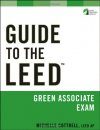![Guide to the LEED Green Associate Exam Guide to the LEED Green Associate Exam]()
Click to have a closer look
About this book
Contents
Biography
Related titles
About this book
Preparing for the LEED-NC Professional Accreditation Exam involves not only an understanding of the LEED-NC rating system, but also of how the LEED process is administered on a project.
This study guide for the LEED-NC Professional Accreditation Exam helps to comprehend each prerequisite and credit in the LEED for New Construction Rating System and understand the responsibilities of the LEED project team administrator in coordinating the project team and in implementing the LEED process. A practice exam completes the student's preparation with hands-on test-taking experience.
Contents
Introduction. PART ONE: Ramping Up. Chapter One: Understanding the Credentialing Process. The Tiers of the Credentialing Process. The First Tier: LEED Green Associate. The Second Tier: LEED Accredited Professional (AP) with Specialty. The Third Tier: LEED AP Fellow. The Application Process. Apply! Register! Schedule! Why Earn the LEED Credentials? Chapter Two: Introduction to the Concepts and Process of Sustainable Design. The Benefits of Green Buildings. The Triple Bottom Line. The Design and Construction Process. The Project Team Members. Conventional Projects vs. the Integrative Design Approach. Do Green Buildings Cost More? Chapter Three: Third Party Verification. USGBC and GBCI. Roles and Responsibilities . The Policies of USGBC and GBCI . Chapter Four: Understanding LEED. The LEED Rating Systems. LEED for New Construction and Major Renovation (LEED NC). LEED for Schools. LEED for Healthcare. LEED for Core & Shell (LEED C&S). LEED for Commercial Interiors (LEED CI). LEED for Retail. LEED for Existing Buildings: Operations and Maintenance (LEED EBOM). LEED for Homes and LEED for Neighborhood Development (LEED ND). The Categories of LEED. Prerequisites and Credits. Credit Weightings. Chapter Five: The LEED Certification Process Summarized. LEED Online. LEED for Existing Buildings. Minimum Program Requirements. The Certification Process for Projects. The Timeframes of Certification Reviews. LEED for Homes and Neighborhood Development. Precertification. Recertification. PART TWO: Diving In: The Strategies & Technologies of LEED. Chapter Six: Sustainable Sites. Site Selection. Strategies. Brownfield Sites. Transportation. Strategies. Promote Alternative Methods of Transportation. LEED for Neighborhood Development. Site Design & Management. Strategies. Stormwater Management. Strategies. Chapter Seven: Water Efficiency. Indoor Water Use . Strategies. Outdoor Water Use for Irrigation. Strategies. Process Water. Strategies. Chapter Eight: Energy & Atmosphere. Commissioning. Minimum Energy Performance. Process Energy vs. Regulated Energy. Refrigerants. Existing Buildings. Strategies to Satisfy Energy & Atmosphere Prerequisites and Credits. Energy Demand. Energy Efficiency. Renewable Energy. Ongoing Energy Performance. Chapter Nine: Materials & Resources. Conducting Life-Cycle Assessments of Building Materials to Determine Selections. Calculating Green Building Products for LEED. Building Material Life-Cycle Impacts. Waste Management. Strategies to Reduce Waste. Chapter Ten: Indoor Environmental Quality. Indoor Air Quality. IAQ During Construction. IAQ During Operations. Strategies. Thermal Comfort. Strategies. Lighting. Strategies. Acoustics. Strategies. Chapter Eleven: Innovation in Design and Regional Priority. Innovation in Design. Regional Priority. PART THREE: Study Tips and Appendices. Chapter Twelve: Study Tips. Preparing for the LEED Green Associate Exam: Week Five. Practice Exam Approach . The Testing Center Environment. Exam Structure. When at the Testing Center. Exam Scoring. After the Exam. Appendices. A. Rating Systems Overview. B. Minimum Program Requirements (MPRs). C. LEED Certification Process . D. Main Category Summaries. E. Trade Offs and Synergies . F. Sample LEED NC Checklist/Scorecard. G. Sample Credit. H. Traditional Project Development vs. Integrative Project Development. I. Referenced Standards. J. Acronyms. K. Answers to Quiz Questions. L. Sample Flashcards. Credits.
Customer Reviews
Biography
Michelle Cottrell, LEED AP, is Vice President and Director of Education at Green Education Services, where she is responsible for curriculum and course development. She is also the founding principal of Design Management Services, a LEED consulting firm that supports project teams through the certification process from design through construction. A LEED Accredited Professional, Cottrell has more than ten years of experience specializing in commercial projects as a sustainable design and LEED consultant. Green Education Services (greenedu.com) is a leading provider of green jobs training related to LEED, energy auditing, solar, and more for building developers, architects, engineers, interior designers, planners, commercial real estate brokers, and other construction industry professionals. A national member of the U.S. Green Building Council and an approved AIA/CES registered provider, Green Education Services has helped thousands of professionals throughout the United States prepare for their credentialing exams.






















![A4A: Architecture for Animals [English / Italian]](http://mediacdn.nhbs.com/jackets/jackets_resizer_medium/24/244049.jpg?height=150&width=113)












